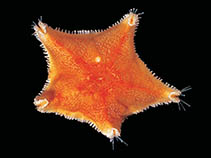Glabraster antarctica (Smith, 1876)
Red spiny cushion star
Classification / Names Populärnamn | synonymer | CoL | ITIS | WoRMS
Asteroidea | Valvatida | Poraniidae
Environment: milieu / climate zone / djupintervall / distribution range Ekologi
; djupintervall 0 - 900 m (Ref. 87801). Polar
Distribution Länder | FAO områden | Ekosystem | Förekomster | Utplanteringar
Southeast Pacific, Southwest Atlantic and Antarctic: Subtropical to polar.
Length at first maturity / Size / Weight / Age
Könsmognad: Lm ? range ? - ? cm
Life cycle and mating behavior Könsmognad | Reproduktion | Lek | Eggs | Fecundity | Larvae
Main reference
referenser | Koordinator | Medarbetare
Murray, J. 1896 On the deep and shallow-water marine fauna of the Kerguelen region of the Great Southern Ocean. Challenger Expedition 343-500 p. (Ref. 87480)
IUCN Red List Status
(Ref. 130435: Version 2025-1)
CITES status (Ref. 108899)
CMS (Ref. 116361)
Threat to humans
Human uses
| FishSource |
Verktyg
Ytterligare information
Födosammansättning
Födointag
Predatorer
Max. ages / sizes
Length-weight rel.
Length-length rel.
Length-frequencies
Mass conversion
Abundans
Internet-källor
BHL | BOLD Systems | CISTI | DiscoverLife | FAO(Publication : search) | Fishipedia | GenBank (genome, nucleotide) | GloBI | Gomexsi | Google Books | Google Scholar | Google | PubMed | Tree of Life | Wikipedia (Go, sök) | Zoological Record



